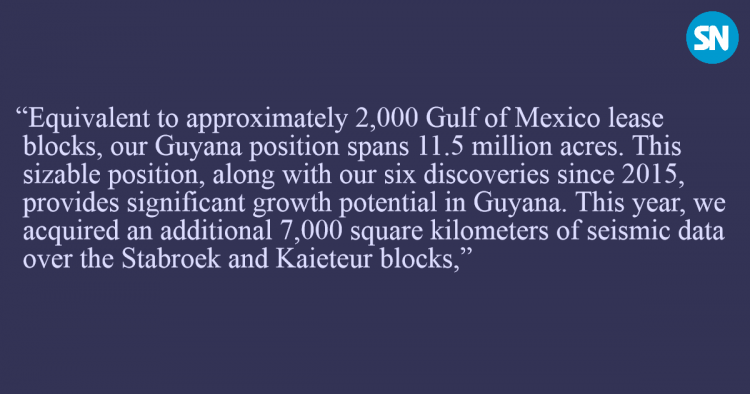
April 4 2018
With seven major discoveries since 2015 and boasting deep-water seismic technologies ahead of their competitors, ExxonMobil has announced that it has identified new oil leads here and will continue to pursue them throughout this year.
“Our proprietary seismic imaging technology helps us see opportunities in the subsurface that others cannot. We successfully used this technology on recent discoveries in the Black Sea and offshore Guyana,” the company told its shareholders in a 110 pages, 2017 Operating and Financial Review, which it released yesterday.
The review also adds that the company has “identified additional leads, and exploration and development activities will continue throughout 2018.”
Informing that it holds more than 11 million acres offshore Guyana, ExxonMobil played up the large volume of space that it has acquired here and pointed out that in the upstream, it was pursuing high impact new opportunities.
“Equivalent to approximately 2,000 Gulf of Mexico lease blocks, our Guyana position spans 11.5 million acres. This sizable position, along with our six discoveries since 2015, provides significant growth potential in Guyana. This year, we acquired an additional 7,000 square kilometers of seismic data over the Stabroek and Kaieteur blocks,” the report states. While adding that it undertook some 30,000 km2 of 3D seismic data acquisition since July 2015, in an area large “enough to cover Belgium”.
The data in the report appears to pre-date the seventh oil find at the Pacora-1 well site which was declared on February 27, 2018.
The report reiterated much of what the company had stated last year even as it pointed out that an additional 7,000 square kilometers of seismic data over the Stabroek and Kaieteur blocks was obtained in 2017.
“We continued our exploration success in Guyana, adding further value to our growing portfolio in the country. We made our sixth significant offshore oil discovery, testing a new play concept for the Stabroek block with the Ranger-1 well. This discovery adds to previous world-class discoveries at Liza, Payara, Snoek, Liza Deep, and Turbot, which are estimated to total more than 3.2 billion recoverable oil-equivalent barrels. Additional exploration drilling is planned on the Stabroek block for 2018, including additional drilling at the Ranger and Turbot discoveries,” the report noted.
In June, the company noted it announced the final investment decision for the first phase of the world-class Liza development, which includes a floating production, storage, and offloading (FPSO) vessel designed to produce up to 120,000 barrels of oil per day. Production is expected to begin by 2020, fewer than five years after discovery, which is four years faster than the industry average. Development planning is progressing for subsequent phases in the greater Liza area. The regulatory process is under way for the Phase 2 FPSO vessel, with capacity up to 220,000 barrels per day and start-up in 2022. Phase 3 will follow closely. These first three phases will develop approximately 2 billion oil-equivalent barrels of the 3.2 billion oil-equivalent barrels discovered to date. Additional phases are being defined to develop, it added.
